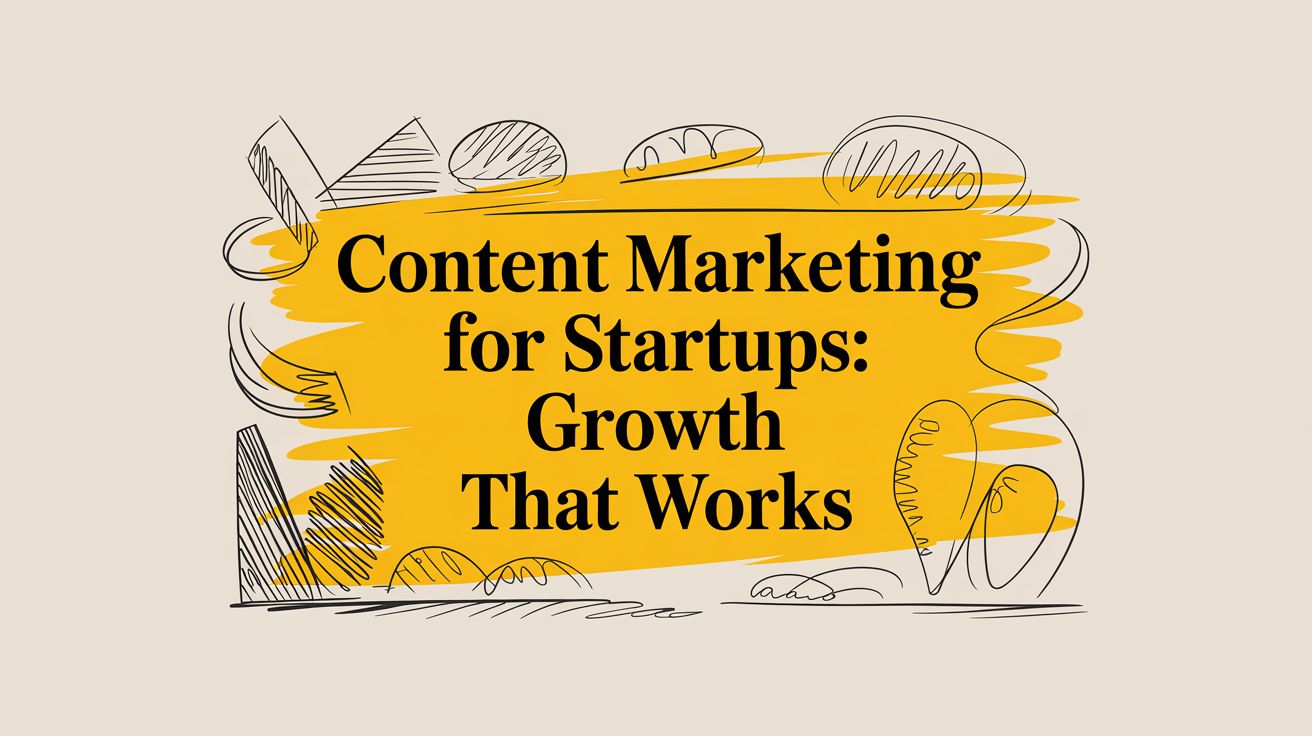content marketing for startups: Growth that Works

Content marketing isn't just about churning out blog posts and videos. For a startup, it’s the art of creating genuinely useful content that solves real problems for a specific audience. It's how you stop shouting about your product and start building trust, turning your brand into the resource people seek out on their own.
Laying a Foundation That Lasts

Jumping straight into content creation without a plan is a classic startup mistake. It’s like building a house on a shaky foundation—you might get a few impressive pieces up, but the whole thing will eventually crumble. The most effective content strategies are built long before a single word is written. It all starts with getting crystal clear on who you're talking to and why they should care.
This initial work isn't just busywork. It's what separates content that gets lost in the digital noise from content that consistently attracts the right customers and actually moves the needle for your business.
Define Your Ideal Customer
You can't create content that resonates if you don’t know who you're creating it for. And I don't mean just basic demographics. You need to get inside the head of the person on the other side of the screen. This means creating a detailed Ideal Customer Profile (ICP) and fleshing it out with specific personas.
Don't just guess. Get your hands dirty with some scrappy, real-world research:
- Interview your first 10 customers. Seriously, get them on a call. Ask what their day-to-day looks like, what challenges keep them up at night, and what finally pushed them to look for a solution like yours.
- Become a fly on the wall in online communities. Where do your ideal customers hang out? Find those Reddit threads, Slack groups, or LinkedIn communities and just listen. The questions they ask and the language they use are pure gold.
- Talk to your sales and support folks. Even if that's just one person (or you!), they're on the front lines. They hear the raw, unfiltered feedback, objections, and pain points every single day.
Getting this right from the start is absolutely crucial. To go a bit deeper, check out this guide on how to create buyer personas that drive B2B growth. It provides a great framework to make sure every article, video, or post you create hits the mark.
Articulate Your Unique Value
Okay, so you know who you're talking to. Now you have to give them a compelling reason to listen. Your Unique Value Proposition (UVP) is the simple, powerful answer to the question, "Why should I pick you over all the other options?"
Your UVP isn't a fluffy marketing slogan. It's a promise. It needs to clearly state the main benefit you provide, for whom, and what makes your approach different.
Let's say you built a project management tool for remote companies. A weak UVP would be "The best project management tool." A strong one? "The first project management platform designed to eliminate asynchronous chaos for distributed teams." See the difference? It's specific, it's targeted, and it immediately highlights what sets it apart.
Set Goals That Actually Matter
Creating content without clear goals is just a hobby. To justify the time, money, and effort, you have to connect your work to real business outcomes. This means dropping vague objectives like "build brand awareness." Get specific by using the SMART goal framework (Specific, Measurable, Achievable, Relevant, Time-bound).
Here’s what that looks like in the real world:
- Vague Goal: "We need more website traffic."
- SMART Goal: "Increase organic blog traffic from 1,000 to 5,000 monthly visitors within six months by publishing two SEO-optimized articles per week."
And another one:
- Vague Goal: "Let's get more leads."
- SMART Goal: "Generate 50 qualified leads per month from our new e-book by the end of Q3."
Setting these kinds of measurable targets gives you a North Star. It helps you justify your budget, prove your ROI to investors, and guide every decision you make—from the topics you cover to the channels you use to get the word out.
Building Your Strategic Content Roadmap

Throwing random content at the wall and hoping something sticks is a recipe for wasted time and money. A blog post here, a social media update there—it feels busy, but it doesn't build a business. You need a map, not just a list of things to do. A solid content roadmap turns scattered efforts into a deliberate growth engine.
This is the critical shift from being reactive to proactive. Instead of waking up and asking, "What should we post today?" you'll have a clear plan. Every article, video, and tweet will be aligned with your bigger goals, whether that’s a product launch or a new sales push. It’s all about creating a cohesive journey that guides people from "Who are you?" to "Where do I sign up?"
Brainstorming Topics That Actually Matter
The best content ideas almost always come from the intersection of two things: your customer's biggest problems and how your product helps solve them. Your brainstorming sessions need to start there. Stop thinking about what you want to sell and start obsessing over what your audience needs to learn.
The easiest way to find these golden nuggets is to go back to your research. What questions are people asking in those forums you joined? What frustrations pop up again and again in customer interviews? What keywords are they punching into Google? These are blinking neon signs pointing you toward content they're desperate to find.
Let’s say you run a SaaS startup with a budgeting tool for freelancers. Your topics shouldn't just be a rehash of your features page. They need to address the real-world headaches of freelance life:
- How to Actually Calculate Quarterly Estimated Taxes
- A No-Nonsense Guide to Setting Profitable Freelance Rates
- 5 Invoicing Mistakes That Are Costing You Money (And How to Fix Them)
See the difference? These topics solve immediate problems and make your product the logical next step.
Adopting the Topic Cluster Model
Once you have a brain dump of ideas, it's time to organize them in a way that builds authority and wins you points with search engines. The topic cluster model is my go-to framework for this. It’s simple: you create one massive, comprehensive "pillar page" on a broad subject, then surround it with shorter "cluster" articles that explore specific subtopics in more detail.
For our freelance budgeting tool, it would look like this:
- Pillar Page: The Ultimate Guide to Freelance Finances
- Cluster Content: (All linking back to the pillar page)
- Choosing a Business Structure: Sole Proprietorship vs. LLC
- The Best Accounting Software for Independent Contractors
- How to Build a Retirement Plan When You're Self-Employed
This structure signals to Google that you’re a true expert on "freelance finances," which helps your entire web of content rank higher. It also creates a fantastic user experience, keeping visitors on your site as they dive deeper into the topics they care about.
By creating interconnected content, you're not just writing articles; you're building a library of expertise. This library becomes a go-to resource for your audience, establishing trust long before they're ready to buy.
Building a Realistic Content Calendar
A content calendar is where your strategy comes to life. It's a living document that maps out what you'll publish, where, and when. For a lean startup, the most important word here is realistic. Don't fool yourself into thinking you can publish daily if you only have the resources for one great article a week.
Consistency trumps frequency every single time.
A well-planned calendar helps you balance different content types—blog posts, videos, lead magnets—and tie them directly to your business goals. If you need a solid starting point, you can find a great framework in this digital marketing plan template.
A structured approach isn't just a nice-to-have; it's what separates the winners from the losers. The data is clear: 80% of highly successful firms have a formal content marketing strategy in place. Planning is directly tied to growth.
To keep your strategy sharp, you have to stay current with the latest content marketing trends. Understanding what’s next helps you build a roadmap that works today and sets you up for success tomorrow.
To give you a clearer picture, here's a simple template showing how a startup could structure its content for a month.
Sample Startup Content Calendar Template
| Week | Blog Post (Top of Funnel) | Lead Magnet (Middle of Funnel) | Social Media Focus | Key Metric |
|---|---|---|---|---|
| Week 1 | "10 Common Mistakes First-Time Founders Make" | Launch: "The Ultimate Startup Checklist" (PDF) | Promote Checklist; share mistake #1-3 from blog post | Lead Magnet Downloads |
| Week 2 | "How to Validate Your Business Idea for Under $100" | Webinar: "From Idea to MVP in 30 Days" | Promote Webinar; share behind-the-scenes of validation process | Webinar Registrations |
| Week 3 | "A Founder's Guide to Angel vs. VC Funding" | Case Study: "How Company X Grew 300% With Our Platform" | Share key stats from Case Study; founder interview clips | Case Study Views |
| Week 4 | "5 Essential SaaS Tools We Can't Live Without" | Email Course: "5-Day Growth Hacking Challenge" | Promote Email Course; ask audience for their favorite tools | Email Course Signups |
This calendar shows how you can target different stages of the buyer's journey each week, ensuring a balanced mix of content designed to attract, engage, and convert.
Creating Content That Actually Converts

Alright, you've got your roadmap. Now it’s time to roll up your sleeves and get to the real work: creating content. This is where your strategy meets reality. The aim isn't just to fill a blog with posts; it's to build a library of assets that pulls in the right people, earns their trust, and shows them why you're the solution they’ve been looking for.
Every single piece you publish needs a job to do. Maybe it’s answering a burning question your ideal customer has or showing off how your product crushes a common pain point. This requires a smart blend of sharp writing, solid SEO, and a voice that sounds like it’s coming from a real human.
Mastering On-Page SEO Essentials
Let's be clear: for a startup, on-page SEO isn't about trying to trick Google. It's about making it dead simple for both search engines and people to understand what your content is about and why it’s worth their time. The key is to chase achievable wins, not waste your limited resources on impossible battles.
A great place to start is with long-tail keywords. Forget trying to rank for a massive, hyper-competitive term like "project management." Instead, get specific. Aim for something like "asynchronous communication tools for remote teams." The search volume is lower, but the intent behind it is sky-high. That means the traffic you attract is far more likely to be qualified.
And then there's your headline. It's your one shot to grab someone's attention. Make it count. A great headline promises a clear solution or benefit and sparks curiosity, all without feeling like cheap clickbait.
- Weak Headline: "Our New Features"
- Strong Headline: "5 New Features That Cut Client Reporting Time in Half"
See the difference? The second one hits a nerve by naming a problem and quantifying the payoff. It’s a click you’ve actually earned.
Choosing the Right Content Format for the Job
Not all content is created equal. A huge mistake startups make is defaulting to blog posts for absolutely everything. A much smarter approach is to match the format to your specific goal and how your audience actually likes to consume information.
Think about what your audience needs at different points in their journey:
- To Build Trust and Authority: This is where in-depth guides, original research, and detailed whitepapers shine. They position you as an expert who genuinely wants to educate the market, not just push a product.
- To Grab Attention and Generate Buzz: Short-form videos, punchy infographics, and data-backed social media posts are your go-to. They’re easy to share and can drive home a single powerful idea in seconds.
- To Drive Conversions: When someone is ready to buy, they need proof. Case studies, product comparison pages, and detailed webinar demos give them the confidence to choose you.
The data backs this up. Video is an absolute powerhouse, with 45% of marketers calling it their best-performing medium. This reflects a bigger shift in what customers want—58% of consumers say they trust brands that offer educational content more than those who just promote themselves. Lean into teaching, and you’ll build a far more loyal audience. You can dive into more of the latest content marketing statistics to see how these trends can inform your own strategy.
Writing Copy That Connects and Persuades
How you say something is just as important as what you say. Corporate buzzwords and fluffy marketing-speak are poison to building trust. You need to write with clarity, empathy, and conviction.
Great copywriting isn’t about using big words. It’s about using simple words to communicate a big idea. Your audience is busy—respect their time by getting straight to the point.
Here are a few simple habits that will instantly make your writing more effective:
- Use an Active Voice: It’s more direct and has more energy. Instead of "The software was designed by our team," say "Our team designed the software."
- Write Short Sentences and Paragraphs: Break up those walls of text! This makes your content much easier to read, especially on the phone, where most people are browsing.
- Address the Reader Directly: Use "you" and "your" to make it feel like a personal conversation. It's a small change that makes a huge difference.
- Focus on Benefits, Not Just Features: Don't just list what your product does. Explain what it helps your customer do. A feature is "one-click reporting"; the benefit is "saving an hour every week to focus on what matters."
Finding and Honing Your Brand Voice
In a sea of competitors, your brand voice is your secret weapon. It’s the unique personality that comes through in everything you create. Are you funny and a bit rebellious like Wendy's, or are you the helpful, straight-talking expert like HubSpot?
Figuring out your voice isn't a one-and-done project. It starts with a few core ideas—like "We are helpful, expert, and approachable"—and gets sharper with every piece of content you ship.
Just look at a company like Ahrefs. They built a massive, loyal following with a voice that is relentlessly practical, data-driven, and no-nonsense. They don't just tell you what to do; they show you how in painstaking detail with real-world examples. That authenticity has made them an industry standard and directly fueled their growth. Your unique voice, applied consistently, can do the same for you.
Getting Your Content Seen by the Right People
Creating brilliant content is only half the battle. So many startups get this wrong. They hit "publish" without a clear distribution plan, and it's one of the quickest ways to watch your time and budget evaporate. The old "if you build it, they will come" mentality just doesn't fly anymore. To actually get results, you need an integrated system for getting your hard work in front of the right people.
For a startup, this doesn't mean you need a massive ad budget. It's all about being scrappy and strategic—leveraging the channels you control, building real relationships, and making small, targeted investments to give your best work a serious push.
Master Your Owned Channels
First things first: focus on the platforms you control directly. Think of them as your home base. They're the most reliable and cost-effective ways to build a direct line to your audience, and you're not at the mercy of some algorithm change.
Your Email List: This is, without a doubt, your single most valuable asset. Unlike a social media following, your email list is a direct line to people who have explicitly asked to hear from you. Use it to share your latest articles, offer up exclusive insights, and gently nudge leads toward becoming customers.
Your Social Media Profiles: Don't just dump links and run. Each platform has its own vibe, its own language. Your job is to repurpose your core content into formats that feel native. Turn a key statistic from your blog post into a sharp LinkedIn graphic. Snip a powerful customer quote and make it an engaging Instagram story. The goal is to start conversations, not just broadcast. If you're stuck, check out these social media content ideas for inspiration on how to adapt your message.
Your Company Blog: Your blog isn't just a content graveyard where you post new articles. It's a living library. Make a habit of using internal links to guide readers from one relevant post to another. This simple tactic keeps them on your site longer and, just as importantly, helps search engines understand the structure and authority of your content.
Pursue Earned Media and Build Relationships
Earned media is any promotion you don't pay for—it's the digital version of word-of-mouth. And it's incredibly powerful for building credibility precisely because it comes from a trusted third party, not from you.
A classic startup strategy here is guest posting. Find non-competing blogs that your ideal customers already read and trust. Don't just pitch a generic article; pitch them a high-value piece that solves a real, painful problem for their specific audience. In return, you'll get an author byline, a valuable link back to your site, and exposure to a brand-new, perfectly relevant audience.
Beyond one-off guest posts, focus on building genuine relationships. Identify the key influencers, journalists, or community leaders in your niche. Engage with their content thoughtfully. Share their work. Offer your unique insights in the comments. When you finally have something amazing to share, you'll be a familiar face, not just another stranger asking for a favor.
A single share from a respected industry voice can drive more qualified traffic than a week's worth of your own social media posts. Relationships are the ultimate distribution hack for startups.
Use Paid Promotion Smartly
When I say "paid promotion," I'm not talking about blanketing the internet with ads. For a startup, it's about surgical strikes. It means using small, highly targeted ad spends to amplify the content that's already performing well.
Think of it as adding fuel to a fire that's already burning. Did a blog post generate a ton of organic comments and shares? Spend $50 to boost it to a lookalike audience on Facebook. Did a specific case study lead to three new customer sign-ups? Promote it on LinkedIn, targeting professionals with the exact job titles as your best customers.
This approach creates a powerful feedback loop. You use organic signals to identify your "hits," and then you use a modest paid budget to extend their reach far beyond your existing audience. This ensures every single dollar you spend has the highest possible chance of delivering a real return.
Content Distribution Channel Comparison for Startups
Choosing where to focus your limited time and money can be tough. The table below breaks down the most common channels to help you decide what makes sense for your startup right now.
| Channel | Typical Cost | Effort Level | Best For |
|---|---|---|---|
| Email Marketing | Low (Platform Subscription) | Medium | Nurturing leads and building long-term loyalty with your core audience. |
| Organic Social Media | Low (Time Investment) | High | Building community, engaging directly with customers, and driving top-of-funnel awareness. |
| Guest Posting | Low (Time Investment) | High | Building backlinks for SEO, establishing authority, and reaching new, targeted audiences. |
| Targeted Paid Ads | Medium (Ad Spend) | Medium | Amplifying proven content, driving conversions, and reaching specific customer segments quickly. |
Ultimately, the best strategy is a mix. Start with your owned channels, build relationships for earned media, and then sprinkle in paid ads to pour gasoline on your best-performing content.
Using Data to Fuel Your Growth

Creating great content is a fantastic start, but if you aren't using data, you're essentially flying blind. For a startup, content marketing isn't an art project with fuzzy goals—it's a growth engine. To get it running smoothly, you have to look past the vanity metrics. Page views and social media likes feel good, but they don't tell you if your content is actually moving the needle for your business.
The real story is in the numbers that connect directly to your bottom line. We need to focus on key performance indicators (KPIs) that prove your content is effective and justify every dollar and hour you pour into it.
Focusing on Metrics That Matter
When you're an early-stage company, every single piece of content has a job to do. That job is to contribute to growth. This means you need to track the metrics that show you're attracting the right people and turning them into potential customers.
Let's cut through the noise. Here are the core KPIs a startup should be obsessed with:
- Qualified Traffic: All traffic is not created equal. You want to see a steady increase in visitors from your target industries, locations, and company profiles—people who actually engage with what you've written.
- Lead Generation: How many people are downloading your e-book, signing up for your newsletter, or requesting a demo after reading a blog post? This is a direct measure of your content’s persuasive power.
- Customer Acquisition Cost (CAC): This one can be trickier to pin down, but it's the ultimate test. Understanding how much it costs to acquire a new customer through your content is what proves its efficiency.
Measuring these KPIs is the foundation for understanding your content's real-world impact. To get a deeper handle on this, it's worth exploring how to measure marketing ROI in a way that gives you truly actionable insights.
Your Startup Data Toolkit
The good news? You don't need a boatload of expensive, complicated software to get going. A couple of free tools from Google are more than powerful enough to shape your entire content strategy.
Google Analytics 4 (GA4): Think of this as your command center for understanding user behavior. GA4 shows you which articles bring in the most engaged traffic, what channels are driving those visitors, and how people navigate your site once they arrive.
Google Search Console (GSC): This tool is your direct line to Google's brain. With GSC, you can see the exact search queries bringing people to your site, your average ranking for those terms, and any technical hiccups that might be holding your content back.
A simple way to think about it: GSC tells you how people found you, and GA4 tells you what they did once they got there. Using them together gives you the complete picture.
Performing a Simple Content Audit
One of the quickest wins you can score with data is by auditing the content you already have. I guarantee you have articles sitting there with huge, untapped potential. A simple audit helps you find these hidden gems.
Start by digging into Google Search Console. Look for pages that get a ton of impressions but have a low click-through rate (CTR). This is a classic sign that your headline or meta description isn't grabbing attention. A quick rewrite can often lead to an immediate traffic bump.
Next, pop over to Google Analytics and find articles that used to perform well but have since tapered off. These are prime candidates for a "content refresh." Update them with new information, add more current examples, or improve the on-page SEO to bring them roaring back to life.
This data-driven feedback loop is what separates the startups that get stuck from those that achieve predictable, sustainable growth. The proof is in the numbers: research shows 74% of marketers confirm that content helps generate leads and demand. Beyond that, 62% highlight its vital role in nurturing those leads, and 52% credit content with building the customer loyalty every startup needs to survive. You can learn more about these startup marketing statistics and see how a data-informed approach unlocks this potential.
Answering the Tough Questions: A Startup's Content Marketing FAQ
When you're just getting started with content marketing, the questions can feel overwhelming. With a shoestring budget and a clock that never stops ticking, you need straight answers, not just theory. Let's tackle some of the most common hurdles I see founders and early-stage marketers face.
Think of this as a quick, practical guide to get you past the uncertainty and into action.
What’s a Realistic Content Budget for a Startup?
There's no one-size-fits-all answer here, but a good rule of thumb is to earmark around 10-15% of your overall marketing budget for content. In the very beginning, that "budget" might be more about your time and sweat equity than actual cash, focusing on what you can write yourself and promote organically.
As you start to see some traction (and hopefully, some funding), you can begin to scale. The most important thing is to view content as an investment. If you spend $500 on a well-researched article and it brings in three qualified leads that close for $5,000, the math speaks for itself. Always track the return.
Seriously, How Long Until This Actually Works?
This is the hardest pill to swallow for most startups. Content marketing is a marathon, not a sprint. Unlike a Google Ad campaign where you see results almost immediately, content builds momentum over time. Realistically, you should start seeing a meaningful impact—like a real lift in organic traffic and consistent leads—in about 6 to 8 months.
Don't get discouraged if your first few blog posts are met with crickets. Instead, look for the small wins. Are a few keywords starting to rank? Are people sharing your content on social media without you asking? Is the bounce rate on your blog getting lower? These are the early signs that you're on the right track.
Of course, this timeline can shrink if you’re in a niche with less competition or if you already have an audience you can tap into. But consistency is non-negotiable. Publishing randomly will just reset the clock every time.
Should We Write Everything Ourselves or Hire Someone?
Ah, the classic build-or-buy dilemma. The right move really hinges on your team's skills and, more importantly, their available time.
- Keep it In-House If: You have someone on the founding team who genuinely knows the subject matter inside and out and can write well. This is fantastic for authenticity and saves cash, but it’s a massive time sink. Don't underestimate that.
- Hire a Freelancer or Agency If: No one on your team has the bandwidth or the writing chops to create great content week after week. It costs money, but you're paying for expertise, speed, and reliability.
Honestly, a hybrid model is often the sweet spot. Have your in-house experts map out the core ideas and provide the unique, proprietary insights only they have. Then, pass that "brain dump" to a talented writer who can shape it into a polished, professional piece. You get the best of both worlds: genuine expertise and high-quality execution.